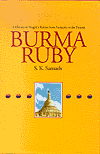|
Burma Ruby: A History of
Mogok’s Rubies from Antiquity to the Present
By S.K. Samuels, 254 pp.,
illus., publ. by S.K.S. Enterprises, Tucson, AZ, 2003. US$45.00
The author, who was born in Burma,
has used his wealth of personal experience in compiling
this book. Dr. Samuels lived under the British rule of Burma
and, later, its occupation by the Japanese during World
War II. After the war, he earned a medical degree from the
University of Rangoon and traveled around the Mogok district.
In 1960, he emigrated to the United States, and did not
return to Burma (now Myanmar) until more than 20 years later.
In Burma Ruby, Dr. Samuels
looks at the Mogok mines from the local perspective, in
contrast to the occidental histories put together by the
“noble enterprise” of colonialism. He tells
much of this history via anecdotes and personal communications,
using a variety of unique Burmese sources, as well as more
traditional references.
In the first chapter, “Lure
of the Ruby,” one of the author’s major points
is that many references to ruby in antiquity fail to note
the actual sources of the material. He concludes that, since
Sri Lankan rubies are predominantly pink, many rubies in
the ancient European references might be from Mogok. Unfortunately,
this deduction ignores the fact that some Sri Lankan rubies
are decidedly red; he also does not take into account any
of the African localities, which produce rubies of very
similar look to Mogok. As one can imagine, attempting to
document anecdotes covering 1,000 years of history is no
easy task.
The second chapter is a concise
natural history of the geography, climate, topography, and
geology of Myanmar, as well as the ethnic and linguistic
groups that make up the complicated land of the ruby. The
next 80 pages deal with the history of Burma leading up
to and through World War II, again relying on local
Burmese legends and histories, prefacing them with this
statement: “Not much credence can be given to such
stories, but they do suggest that rubies and other precious
gems were known, valued, and used by inhabitants of the
country for a long time.”
The following chapter, “Developing
the Post-War Gem Trade,” first describes the escalating
political and economic problems leading up to the March
1962 military coup and beyond. It then looks at development
of the Myanmar Gems Corporation and the auctions held by
the Union of Myanmar Economic Holdings Limited.
In the “Stone Tract”
chapter, the author discusses the Mogok area itself, covering
the geography, geology, and mines. Briefly mentioned are
the Mong Hsu mines, which today produce most of the world’s
rubies (albeit, treated). At the end of the chapter, he
discusses rubies and their classification, as well as the
sapphires of Burma.
Next is a section of unnumbered
pages with 33 color plates. Most are original photos by
the author, and all have interesting gemological themes,
including pictures of the palaces, King Thibaw’s ruby-encrusted
slippers, and a flawless sapphire of approximately 20 carats,
offered for $100,000 in 2002 by a private party. The tragedy
is the poor color reproduction. Fortunately, the black-and-white
photos throughout the book are of better quality.
In “Properties of Burmese
Rubies and Sapphires,” Dr. Samuels mixes gemology
with emphasis on local customs. For instance, he mentions
that the color is due to impurities such as chromium, but
then goes on to discuss the term pigeon’s blood.
He is accurate in commenting that, while such terms are
relics of the past, they carry a certain romanticism that
is very important to gemstones.
The chapter titled “Smuggling,
Heat Treatment, and Provenance of Burma Rubies” presents
some stories that are quite amusing, including how the 496.5
ct SLORC ruby (named for the country’s State Law and
Order Restoration Committee) came to be spirited out of
the country and back again. Heat treatment and provenance
are mentioned briefly, but not from a scientific standpoint.
The chapter ends with a list of five local gem labs that
do origin reports, along with addresses.
“The Gem Trade in Modern
Burma” covers the economic structure of Burma, exchange-rate
issues, and the country’s poor economic performance
of the last decade. The author also covers the annual gem
emporium, but only in general terms (mostly just in table
form), without any photos or depictions of specifics.
“Buying Gems in Burma”
includes a short history of Rangoon, plus the ins and outs
of trying to buy at the MGE auction or at Rangoon’s
Gems Museum. Dr. Samuels gives a rather simplistic summation
of three of the C’s (color, clarity, and cut), plus
common precautions to take when buying.
Following the author’s closing
remarks are various appendices, especially of interest for
Burma-philes. There is also a somewhat limited bibliography
of works cited. One major flaw of the book, given the breadth
of issues it covers, is that it lacks an index.
All in all, while there is some
interesting information here, the book would have benefited
greatly from better editing and production.
WILLIAM LARSON
Pala International
Fallbrook, California
Note:
The above review appeared in the Winter 2003 issue of Gems
& Gemology, pp. 348–349.
Further Reading
|
